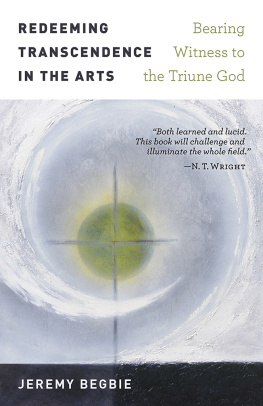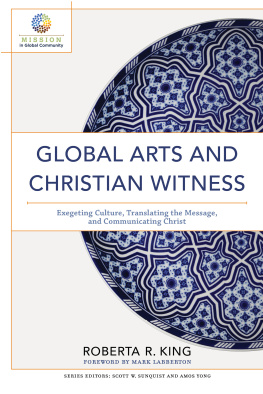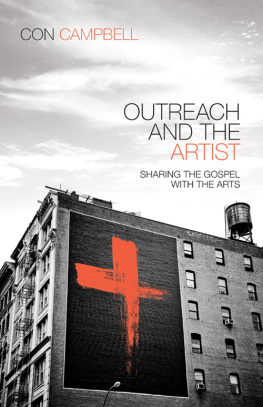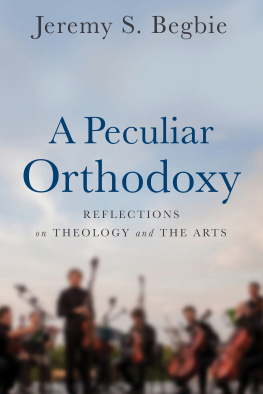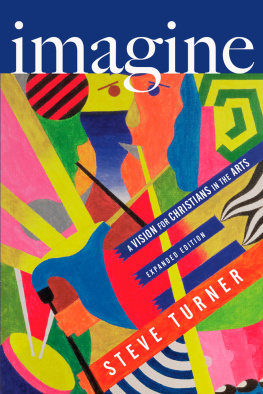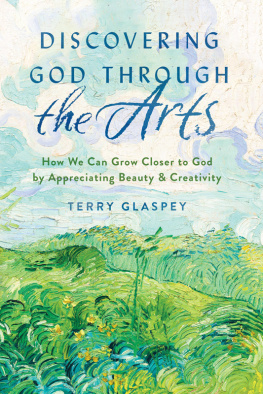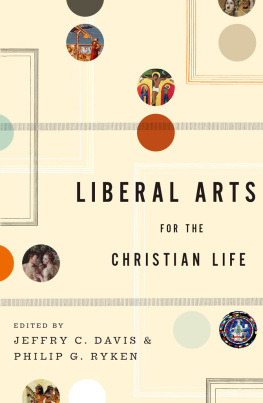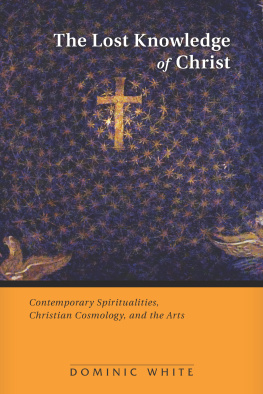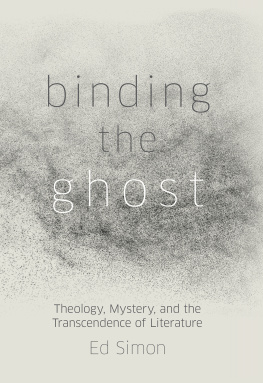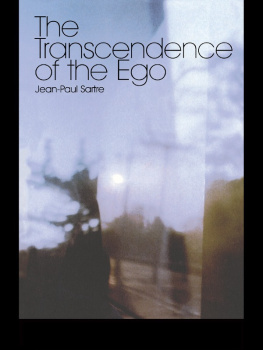Redeeming Transcendence in the Arts
Bearing Witness to the Triune God
Jeremy Begbie
WILLIAM B. EERDMANS PUBLISHING COMPANY
GRAND RAPIDS, MICHIGAN
Wm. B. Eerdmans Publishing Co.
2140 Oak Industrial Drive N.E., Grand Rapids, Michigan 49505
www.eerdmans.com
2018 Jeremy Begbie
All rights reserved
Published 2018
2726252423222120191812345678910
ISBN 978-0-8028-7494-8
eISBN 978-1-4674-4939-7
Library of Congress Cataloging-in-Publication Data
Names: Begbie, Jeremy, author.
Title: Redeeming transcendence in the arts : bearing witness to the triune God / Jeremy S. Begbie.
Description: Grand Rapids, Michigan : William B. Eerdmans Publishing Company, [2018] | Includes bibliographical references and index.
Identifiers: LCCN 2017035593 | ISBN 9780802874948 (pbk. : alk. paper)
Subjects: LCSH: Christianity and the arts. | Transcendence of God. | Trinity.
Classification: LCC BR115.A8 B438 2018 | DDC 261.5/7dc23
LC record available at https://lccn.loc.gov/2017035593
About the cover art:
Power of God from the series In a Word, Anneke Kaai,
www.annekekaai.nl.
We cannot consider the power of God in isolation from his Fatherhood, expressed here in the undefined, limitless white that embraces and supports the earth. The black strip to the right below symbolizes death, stopped dead in its tracks by Gods power, the cross of Christ. (Psalm 77:14, 15a: You are the God who performs miracles; you display your power among the peoples. With your mighty arm you redeemed your people.) Anneke Kaai
Contents
This book comprises an expansion of the Stob Lectures delivered at Calvin College, Grand Rapids, Michigan, in November 2014. My warm thanks go to the faculty and students of both Calvin College and Calvin Theological Seminary for their welcome, hospitality, and probing questions. In particular, I would like to thank Calvin College president Michael Le Roy and Calvin Seminary president Julius Medenblik for their kindness during that visit; Suzanne McDonald for her endless energy, encouragement, and wisdom; and Jon Pott, formerly (and famously) of Eerdmans, who provided much-needed encouragement during the early stages of this book. Various kind friends and colleagues have read and commented on portions of the script: in particular, my gratitude goes to my right-hand man at Duke, Daniel Train, assistant director of Duke Initiatives in Theology and the Arts, for his immense wisdom and kindness on so many fronts; and to Richard Bauckham, Christina Carnes Ananias, Brian Curry, Stephanie Gehring Ladd, Brett Gray, Joelle Hathaway, Nate Jones, Murray Rae, David Taylor, and Andrew Torrance. I am grateful, as always, to my assistant Hillary Train, whose boundless calm and diligence have been crucial in getting this book to press; to James Ernest of Eerdmans, for his keen interest in the project throughout; to Alice Soulieux-Evans for completing numerous research, bibliographical, and copyediting tasks; and above all to my wife, Rachel, for her ceaseless patience and support. The book is dedicated to Malcolm Guite, a poet-priest-theologian whose extraordinary insight and counsel I have come to value more than I could ever tell. I am thankful to Canterbury Press for allowing me to use two of his published poems, and to Malcolm himself for composing two new sonnets to accompany this text.
An urge for transcendence is what makes most people want to write, paint, sculpt, or dance in the first place.
Bill Friskics-Warren, Ill Take You There
One of the more striking features of the current conversation between theology and the arts is the pervasiveness of talk of transcendence. Not surprisingly, this readiness of artists to talk of transcendence has been noticed by many scholars and academics, some of whom have taken the issue in explicitly theological directions.
It is my purpose in this book to ask: What kind of theological weight can be given to the language of divine transcendence when it is associated with the arts? More succinctly: How, if at all, might the arts bear their own kind of witness to divine transcendence?
Many are reluctant to give any serious theological credence to transcendence-talk in connection with the arts, given the fluidity of terms often used and the kind of aesthetic special pleading that seems to swerve dangerously close to idolatry. As for myself, I am not convinced a wholesale skepticism is in order. I have come to believe that there is something worth exploring seriously hereindeed, something that the church needs to address if it is to exercise an effective and winsome witness in our contemporary cultural moment. At the same time, when it comes to interpreting and evaluating such purported rumors of transcendence in the arts, I have also come to believe that we have often been doing so with theological tools that are distinctly blunt and impotent (and are sometimes simply the wrong tools). In a proper eagerness to make common cause with those of little or no explicit faith, we have too frequently lost a sense of the disturbing particularities and disruptive power of the vistas presented in the Old and New Testaments. I will argue that if we pay greater attention to the highly distinctive contours opened up by a scriptural imagination and the creedal traditions that resonate with them, we will be led to question at least some of the more common ways transcendence is being related to the arts today, and discover far richer resources for engaging constructively what is undoubtedly a widespread conviction that the two are in some sense profoundly linked.
I am not implying that we should close down conversations with those who count themselves outside the Christian church but who find in the arts a source of ineffable wonder and pleasure. Quite the opposite. For the last twenty years or so, I have been involved in hundreds of conversations of this sort. But my experience has convinced me that most is gained when we refuse to disregard or downplay the primary sources that ground the churchs faith, and the kind of worldview they invite us to live into and live out in the world. Indeed, one of the main burdens of this book is to challenge the assumption that focusing on the stubborn, historically grounded particularities of biblical faith (and biblically shaped doctrine) will inevitably weaken our ability to engage with appeals to divine transcendence in our culture at large.
Not surprisingly, in this book we will struggle with language, But examining and re-forming terms and the concepts that go with them are only part of the task. As an army of philosophers remind us, language is always language-in-use, embedded in the many-layered densities of practical and communal life. We need to be alert not only to language in and of itself but also to the work our language does (and could do) amidst the arts. What matters in the long run is the way the arts are done, what we do with them, and what happens through them. This will be especially important in our final chapter: the renewal of terms is only one part of the job and, in the long run, fairly pointless if not enacted in fresh interpretation of the arts and renewed artistic activity.
In case there is confusion, my chief interest is not in what are commonly known as the transcendentalsclassically truth, goodness, and beauty. Attempts to relate this trio and its many variants to the arts are not hard to find these days (beauty is enjoying special favor at present). But my concern here is first and foremost with divine transcendence, the transcendence of the God evoked in Scripture, and how this might affect our involvement with the arts. I have no wish to discard out of hand accounts of the arts as bearers of the so-called transcendentals (or ideals, universals, and so forth), nor do I wish to suggest that the transcendentals (in whatever version) have no theological significance. But I do question the wisdom of orienting a discussion of divine transcendence in the arts around philosophical traditions of this sort a priori, lest the singular perspectives opened up by Scripture and carried forward in the churchs traditions are muffled or skewed, and thus not allowed to exercise their distinctive power.

